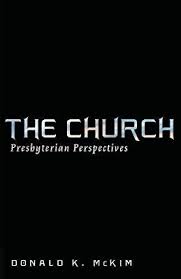McKim, Donald K. The Church: Presbyterian Perspectives. Eugene, OR: Cascade Books, 2017, pp. 108, $15.43, softcover.
Donald K. McKim (PhD, University of Pittsburgh) is a retired minister in the Presbyterian Church (USA). He served for some years as Academic Dean and Professor of Theology at Memphis Theological Seminary, and in recent years has devoted much of his time to writing. Dr. McKim has written many books relating to Reformed theology and Presbyterian ecclesiology, including books on Martin Luther and John Calvin, and the well-received Westminster Dictionary of Theological Terms, now in its second edition.
This current short volume, The Church, is a collection of six messages (thus six chapters) given to various assemblies of clergy and laity. As stated in the preface, these comprise a “theological reflection on the nature of the church” (p. ix). Though this is admittedly an introduction on such matters, Dr. McKim covers some of the more fundamental topics with reflections that span from devotional to theological. His writing style is very lucid. Immediately noticeable is his extensive use of quotes from some of the great theologians of the past, including Barth, Bonhoeffer, and well over 50 quotes from Calvin. Such weaving of words from these great theological minds into a more modern understanding of the nature of the church is very helpful, and keeps the discussion well-grounded.
The first of the six chapters is an effective devotional on the Call to Follow Jesus in the Church. Using the common acronym JOY, McKim states that following Jesus involves Joining ourselves to him by faith, Obedience to Jesus, and then Yielding to Jesus by denying ourselves (Mark 8:34). By way of application McKim asks, “What does our discipleship (our following Jesus) look like?” (p. 8). “We are connected” he says, “with someone who is going somewhere.” When Jesus bids us to follow him he invites us “to be a part of his work in history” (p. 8). Following Jesus involves “activity, movement, and growth,” without which “we are not truly followers” (p. 9). We are then enjoined to leave the past behind and look toward the future, to Jesus as our standard. “What matters most, and always, is whether what we are and what we do can be understood as following Christ” (p. 13).
Chapter two tackles the Latin phrase common in Presbyterian and other Reformed churches, ecclesia reformata, semper reformanda secundum verbi dei, which is translated “the church reformed and always being reformed according to the Word of God.” McKim provides good insight and a great overview of some of the scholarly analyses of this phrase, and leans toward a more liberal understanding. “This is why as Reformed people we are open both to new expressions of our faith, as in new declarations or confessions of faith as well as to the “revisability” of our confessional understandings based on insights from Scripture and the work of the Holy Spirit” (p. 22).
So does this mean the Christian faith must be open to endless revisions, or that the more a church changes its confession of faith the more reformed it is? I’m sure McKim would agree not, but where does one draw the line? Many conservative Presbyterian scholars would argue that to be Reformed (capital R) is to be as close to the biblical teachings of Christ and the Apostles as possible, which was what Luther and Calvin were aiming for in their striving to reform the church from its medieval distortions. So the “always reforming” would refer to the course adjustments needed from time to time to keep churches on the narrow way toward ecclesia reformata, the Reformed (truly biblical) Church.
McKim goes on to emphasize “openness” in a brief discussion of adiaphora, saying, “surely we should sit loose with a number of things.” Adiaphora (indifferent), refers to matters that are “neither commanded nor forbidden in the Word of God” according to the Formula of Concord of 1577. The author does not provide any specific examples, but of course such openness has a lot of wiggle room depending on how one interprets “commanded” and “forbidden.” With regard to controversies such as worship styles, gender roles, definition of marriage, and sexual identity, not only are there differences in how one does hermeneutics, but there is also the question of how much the world should be allowed to influence the church versus how effectively the church should be salt and light to the world, a question all churches struggle with.
The next three chapters are taken from the last section of the Apostle’s Creed with its focus on the Holy Spirt, the holy catholic Church, and the communion of saints. McKim draws deeply from Calvin and Barth here as he reflects on the ministry of the Holy Spirit in the life of the Church. He distinguishes well between the invisible true Church of God’s elect and the visible church, while cautioning strongly against leaving her.
The last chapter “Imagine the Church!” is motivational. Here McKim does a particularly good job of addressing the Presbyterian emphasis on the providence of God who preserves all of creation, accompanies his people through relationships, and governs or directs all things according to his purpose.
In addition to this book, a student interested in studying the nature of the church from a Reformed perspective would do well to read two recent books co-authored by Michael Allen and Scott R. Swain: Reformed Catholicity: The Promise of Retrieval for Theology and Biblical Interpretation (Baker, 2015) and Christian Dogmatics: Reformed Theology for the Church Catholic (Baker, 2016).
David Farbishel
Grand Canyon University, Phoenix, AZ




